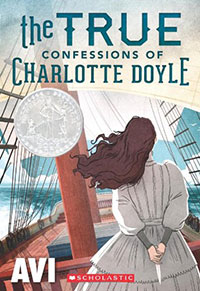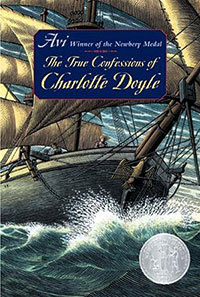
I began the last story about a story by telling how Book A (Something Upstairs) led to Book B (The Man who was Poe). Here is the story how the Poe book led to Book C, The True Confessions of Charlotte Doyle.
Poe is generally credited with having invented the detective tale with his short story, Murders on the Rue Morgue. (1841) That story, profoundly influential, also came to be known as a “Locked Room Mystery.” Which is to say something happens in a room that is presumably inaccessible.
Well, I thought, living as I was on the edge of the Atlantic Ocean, what could be more of a “locked room” than a sailing ship at sea?
If you turn to page 129 of The Man Who Was Poe, you will find these words by a character named Captain Elias:
“Now, Master Edmund, if you’ve time to hear a good yarn, I’ve one for you. You see, The Lady Liberty, had a sister ship. Seahawk, her name was—”
 When I wrote those words, it was the beginning of my thinking of The True Confessions of Charlotte Doyle: I would write a mystery set on a 19th Century sailing ship. I even signed the contract to write a book which, for the moment, was called The Seahawk.
When I wrote those words, it was the beginning of my thinking of The True Confessions of Charlotte Doyle: I would write a mystery set on a 19th Century sailing ship. I even signed the contract to write a book which, for the moment, was called The Seahawk.
But I didn’t begin the book. The first problem was that for about eight months, I moved to Venice, Italy. My wife had a sabbatical and a former editor of mine offered a Venetian apartment. I could not resist.
Indeed, Venice was a fabulous experience.
However, I had not reckoned on two things. Being surrounded by the Italian language (or the Venetian version of it) meant that I was, to my great surprise, radically hampered in my writing. It crimped my rhythms, made my English excessively formal and ornate, and stunted my vocabulary. Also, this being in the early days of portable computers, I had no access to a printer. A key part of my writing process was missing.
I stopped writing the book. All I could do was think about it.
 Only when I returned to Providence did I resume writing, and by then the book had become The True Confessions of Charlotte Doyle. It also began as a mystery, and while it has elements of that, it floated on to become something rather different.
Only when I returned to Providence did I resume writing, and by then the book had become The True Confessions of Charlotte Doyle. It also began as a mystery, and while it has elements of that, it floated on to become something rather different.
The book was done (I thought) when editor Richard Jackson called. “I’ve been thinking,” he said. “We missed something. When Charlotte leaves the boat after the voyage, she doesn’t say goodbye to the crew. That’s out of character.”
Which is to say, since I had written the ending, I knew she would return to the ship. But at the narrative moment, she did not. So I wrote that farewell scene on page 199. When the character Ewing says, “You’re my mermaid now,” I had tears in my eyes because like so many readers, I too had fallen in love with Charlotte but it was time for me to say “Bon voyage.”
But wait! That was not the end of The Seahawk. She reappears in another book! I’ll tell you all about it in proper sequence.
5 thoughts on “Story Behind the Story #22:<br>The True Confessions of Charlotte Doyle”
This is my favorite book of yours that I’ve read, so far. Thanks for sharing the stories behind the stories. It’s been interesting and led me to new books I’ve not read before.
My favorite, too. I discovered it twenty plus years ago in an adolescent literature class. And just yesterday I discussed Crispin — another favorite — with a young reader.
I’m loving these behind-the-scenes glimpses into your work. Thank you!
This is a favorite to read, and to teach. My paperback is held together with an elastic band, with all my annotations! And I forgot to bring it to a conference where I would have a chance for you to sign it (I was one of the lucky ones to be “assigned” to you during my favorite of the conference, the Author’s Roundtable.) I was SO ANGRY at myself for forgetting the dilapidated and much loved book!! There is so much there that is rich for teaching and learning. Thank you for this story.
My favorite Avi book! I have always wondered about Charlotte’s next adventure!
I have the fondest memories reading this book aloud to my children then putting it in the hands of countless others. Charlotte is one of my favorite characters in children’s literature.